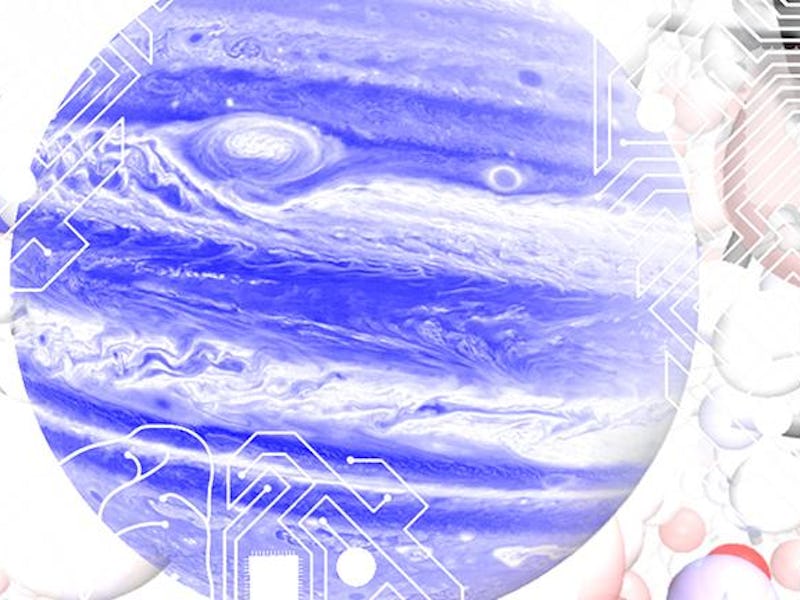Inside Jupiter, hydrogen gas smoothly becomes metal, scientists reveal
"The higher the temperature, the more metallic it becomes."

Hydrogen is the simplest element in the universe, made up of one proton and one electron. It is also the most abundant, accounting for about 75 percent of all normal matter.
Inside the gassy cores of giant planets such as Jupiter, Neptune and Saturn, hydrogen is the main component. But while it remains a molecular gas on the surface, inside, hydrogen transforms into a metal within the planets' deep interior.
The process by which it does so remained a mystery, until now. A team of researchers used an Artificial Intelligence system to recreate the process by which hydrogen transforms itself, revealing that a gradual and smooth process underlies this monumental change in state.
Their findings were detailed in a study published Wednesday in the journal Nature.
Hydrogen transforms into metal inside gas giants like Jupiter through a smooth and gradual process.
Bingqing Cheng, a researcher at the University of Cambridge and lead author of the new study, wanted to identify the process by which hydrogen turns into metal in order to better understand what goes on on the inside of these giant planets in our Solar System and beyond.
"The higher the temperature, the more metallic it becomes."
"Experimentally, it's very hard to do due to the difficulties of recreating the extreme pressure conditions of the interior of a giant planet in a laboratory setting," Cheng tells Inverse.
Instead, Cheng and her team used machine learning to mimic these conditions and observe the interactions between the hydrogen atoms.
Within a low pressure environment, hydrogen is a gas. But as the pressure increases inside these giant planets, the spacing between different hydrogen molecules decreases and the covalent bonds inside hydrogen molecules break. The hydrogen atoms then run around in a liquid state, and the electrons break free from the atoms. These electrons become the electrons found in the metal, and so the gas turns into a metal that conducts electricity.
"In this process, as you increase the pressure it slowly becomes metallic," Cheng says. "The higher the temperature, the more metallic it becomes."
A smooth process — The researchers were surprised to find that the transition is gradual and smooth. Previous attempts to explain the transition have assumed that it was a sudden change from gas to metal, the same way that water transitions from liquid to gas when you boil it.
Even below the boiling point of 100 degrees Celsius, the water is still in its liquid state and suddenly changes to gas once it is boiled. But inside giant planets, the change is gradual.
"When you dive inside Jupiter, all the changes you experience is a smooth transition," Cheng says.
The center of Jupiter and other giant planets like it are much different than that of the Earth. The Earth has a rocky core composed of heavy elements such as iron and silicon, while Jupiter, Neptune, Uranus, Saturn and many of the known exoplanets are made up mostly of gas.
The recent study can also help researchers identify why Jupiter has certain unusual characteristics, like a strong magnetic field and an intrinsic luminosity.
"The transition process of hydrogen is still happening now, right now even as Jupiter is well formed," Cheng says. "This is really a conclusion about the current state of the planet."
Abstract: Hydrogen, the simplest and most abundant element in the Universe, develops a remarkably complex behaviour upon compression1. Since Wigner predicted the dissociation and metallization of solid hydrogen at megabar pressures almost a century ago2, several efforts have been made to explain the many unusual properties of dense hydrogen, including a rich and poorly understood solid polymorphism1,3,4,5, an anomalous melting line6 and the possible transition to a superconducting state7. Experiments at such extreme conditions are challenging and often lead to hard-to-interpret and controversial observations, whereas theoretical investigations are constrained by the huge computational cost of sufficiently accurate quantum mechanical calculations. Here we present a theoretical study of the phase diagram of dense hydrogen that uses machine learning to ‘learn’ potential-energy surfaces and interatomic forces from reference calculations and then predict them at low computational cost, overcoming length- and timescale limitations. We reproduce both the re-entrant melting behaviour and the polymorphism of the solid phase. Simulations using our machine-learning-based potentials provide evidence for a continuous molecular-to-atomic transition in the liquid, with no first-order transition observed above the melting line. This suggests a smooth transition between insulating and metallic layers in giant gas planets, and reconciles existing discrepancies between experiments as a manifestation of supercritical behaviour.